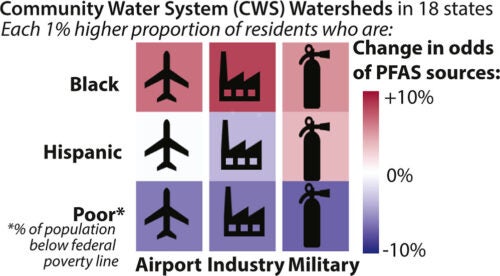
Research findings from STEEP Project One: Exposure were prominently featured in a recent video segment on ABC News.
Environmental hazards are disproportionately placed near marginalized communities, and the factors underlying this issue are multifaceted and systemic. A recent study published by STEEP researchers in the Harvard University Sunderland Lab is the first to evaluate the effects of PFAS on communities in the context of environmental justice. The findings reported in this study match with previous studies that examined how pollution disproportionately affects Black, Hispanic/Latino, and economically underserved communities.
Research used statistics to test relationships between the odds of PFAS contamination and three main factors: 1) drinking water PFAS levels and point sources of PFAS; 2) PFAS point sources and sociodemographic factors; and 3) drinking water PFAS levels and sociodemographic factors.
The odds of detecting PFAS in community water system (CWS) watersheds increases with proximity to point sources of PFAS pollution within the same watershed. This trend is especially true for AFFF-certified (Aqueous Film Forming Foam) facilities, such as military bases. Though the use of AFFFs in firefighting is decreasing, sites contaminated by past use continue to pollute nearby public water sources. Before this study, models of watershed PFAS contamination pointed to a few large sources of contamination as being most influential. This study found that many smaller sources of PFAS can be as problematic.
Watersheds with PFAS sources tend to serve greater proportions of people of color, especially Hispanic/Latino and Black populations. Researchers found for every 1% increase in non-Hispanic Black residents, the odds of sharing a watershed with a PFAS source (industrial facility, airport, fire training areas) increased between 6% and 9%. When comparing PFAS contaminated water sources and demographics, researchers found Hispanic and Latino residents were twice as likely to be served by public water sources with detectable levels of PFAS.
This study also evaluated the role of socioeconomic status and PFAS contaminated drinking water, uncovering a complex relationship between poverty and PFAS dependent on proximity to rural or urban watershed. In rural areas, residents under the federal poverty line had 10% greater odds of having detectable PFAS in their water systems. However, as urban areas tend to have more pollution sources, there was no clear association between urban poverty and PFAS contaminated water.
As of this writing, PFAS contamination levels for drinking water are not federally-regulated. Research suggests thorough reporting and record-keeping will fill data gaps on PFAS contamination in drinking water in the context of sociodemographics. Further data will help refine regulatory limits on pollutants in water systems across the country.
The authors of this study acknowledge that the relationship between drinking water quality and socioeconomic status are complex and multi-layered, as are the factors that influence the proximity of communities of color to large PFAS sources. Many of these underlying problems are systemic, such as historical segregation, information access, and participation in policy/decision-making. PFAS solutions must take environmental justice and disparities into account to effectively address the needs of all communities.
Liddie, J.A., Schaider, L.A., Sunderland, E.M. 2023. Sociodemographic Factors Are Associated with the Abundance of 2 PFAS Sources and Detection in U.S. Community Water Systems. Enviro. Science & Technology. 13:35:37. DOI: https://doi.org/10.1021/acs.est.2c07255.

